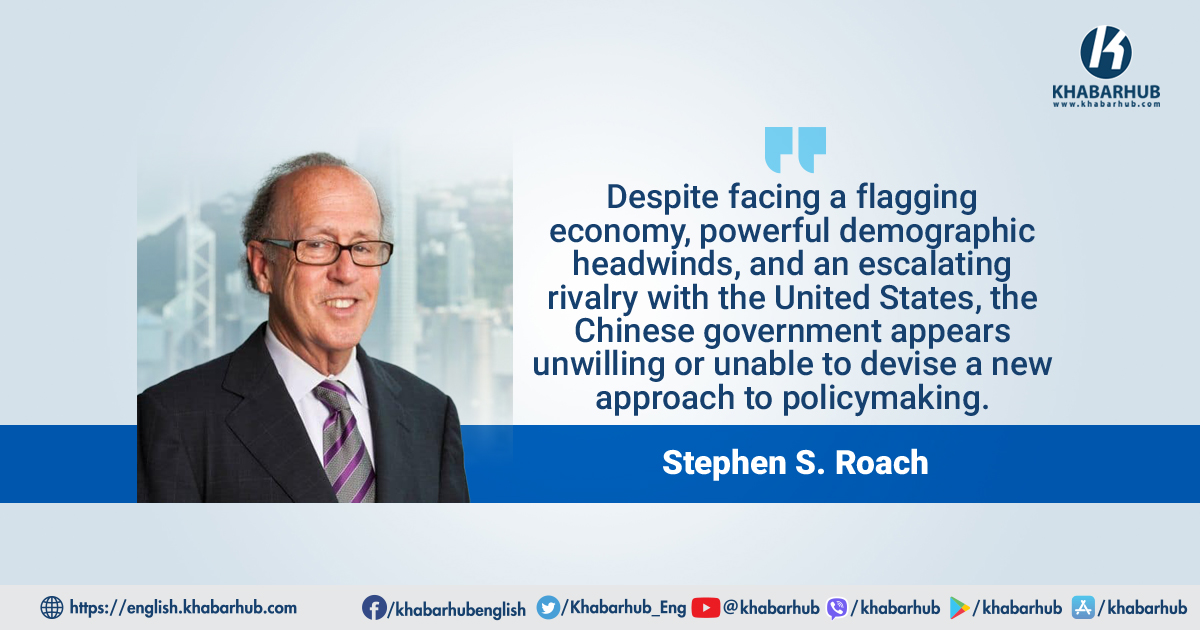China is at a critical juncture. Its deflation-prone debt-intensive economy is seriously underperforming.
Its government has become embroiled in a major superpower conflict with the United States.
And it is staring down the barrel of a demographic crisis. Worst of all, Chinese authorities are responding to these challenges more with ideology and stale tactics from the past, rather than with breakthrough reforms.
Imaginative solutions to tough problems are in scarce supply.
As a diehard China optimist for most of the past 25 years, I haven’t come to this conclusion lightly.
My Yale course, “The Next China,” made the case for a powerful shift in the Chinese growth model, from an investment- and export-led economy to one driven by domestic consumption.
Yes, I worried that China’s porous social safety net – both for retirement and health care – could lead to a rise in fear-driven precautionary saving that would inhibit consumer demand. But, viewing these concerns more as challenges than risks, I remained convinced that China would ultimately rebalance its economy.
I began to have serious doubts in 2021, when Chinese regulators clamped down on internet-platform companies.
With this assault taking dead aim at entrepreneurs, I warned of a mounting “animal spirits deficit.”
Academics have drawn attention to several prominent sources of productivity growth – technology, investment in human capital, research and development, and inter-industry shifts in the mix of national output.
In my latest book, Accidental Conflict, I widened my concerns to include the implications of President Xi Jinping’s “common prosperity” campaign, which targeted the wealth creation of Chinese risk-takers.
And then, a year ago, I threw in the proverbial towel; in “A China Optimist’s Lament,” I argued that the government’s newfound fixation on national security would further diminish China’s potential for economic dynamism.
I have taken a fair amount of flak for this change of heart, especially from long-biased US politicians and their media consorts.
Surprisingly, the Chinese have been more open to debate, especially over the possibility that the Next China is starting to look more like the Next Japan.
After discussing these concerns with a wide range of senior officials, business leaders, academics, former students, and friends in a series of visits to China over the past few months, three conclusions emerge:
First, the Chinese policy response to a flagging economy is unenlightened.
The government is relying on what it has long called “proactive fiscal stimulus and prudent monetary policy” to support economic growth of around 5% in 2024 (Premier Li Qiang will officially announce the target at the National People’s Congress in March).
As was the case in the aftermath of the Asian financial crisis of 1997-98 and the 2008 global financial crisis, China is once again resorting to the brute force of large cash infusions to address today’s major dislocations in the property market, local-government financing vehicles, and the stock market.
Second, such short-term countercyclical tactics do not effectively address China’s long-term structural problems.
According to estimates by the United Nations, China’s working-age population peaked in 2015 and will decline by nearly 220 million by 2049.
Basic economics tells us that maintaining steady GDP growth with fewer workers requires extracting more value-added from each one, meaning that productivity growth is vital.
But with China now drawing more support from low-productivity state-owned enterprises, and with the higher-productivity private sector remaining under intense regulatory pressure, the prospects for an acceleration of productivity growth appear dim.
Lastly, the government keeps sharpening its focus on internal security.
This is true of recent anti-corruption efforts aimed at the military, as well as the on-again, off-again, and now back on-again regulatory assault on the private sector.
In a prescient warning of the Asian financial crisis, Krugman stressed that these economies ultimately failed to follow through on the inspirational genius embedded in the Solow productivity residual – call it a lack of imagination.
For example, the gaming industry is once more under scrutiny, as are several high-profile foreign executives.
Moreover, the recently concluded Third Plenum of China’s Central Commission for Discipline Inspection underscored the importance of ideological discipline as a foundational value.
To that end, the Communist Party has effectively taken over some of the country’s leading educational institutions, including Tsinghua, Shanghai Jiaotong, Nanjing, and Fuzhou Universities.
I worry most about Chinese productivity, especially as aging now takes a toll on its workforce.
Productivity is just as important for China’s market-based socialist system as it is for a capitalist economy.
Academics have drawn attention to several prominent sources of productivity growth – technology, investment in human capital, research and development, and inter-industry shifts in the mix of national output.
The late Robert Solow, the inventor of modern growth theory, put it best, framing productivity is as a “residual” proxy for technological progress after accounting for the physical contributions to output made by labor and capital.
Paul Krugman, in a celebrated 1994 Foreign Affairs article, brought the Solow growth-accounting framework to life in thinking about economic development.
Without a more imaginative approach to economic stewardship, China could remain stuck, unable to muster the courage that its reformers drew on so successfully in the past.
The vaunted performance of the fast-growing East Asian tigers, Krugman argued, reflected the “catch-up” growth achieved by building new capacity and bringing workers from low-productivity rural areas to higher-productivity cities.
In a prescient warning of the Asian financial crisis, Krugman stressed that these economies ultimately failed to follow through on the inspirational genius embedded in the Solow productivity residual – call it a lack of imagination.
My last three visits to China have led me to a similar conclusion.
The Chinese leadership is suffering from an increasingly worrisome imagination deficit.
Their deeply entrenched countercyclical policy mindset is at odds with mounting deflationary risks, exacerbated by the lethal interplay between a rapidly aging population and serious productivity problems.
At the same time, the government is stifling innovation through a barrage of regulations, attempting to draw inspiration from ideology.
Without a more imaginative approach to economic stewardship, China could remain stuck, unable to muster the courage that its reformers drew on so successfully in the past.
(Stephen S. Roach is a faculty member at Yale University and former chairman of Morgan Stanley Asia)
Copyright: Project Syndicate









Comment